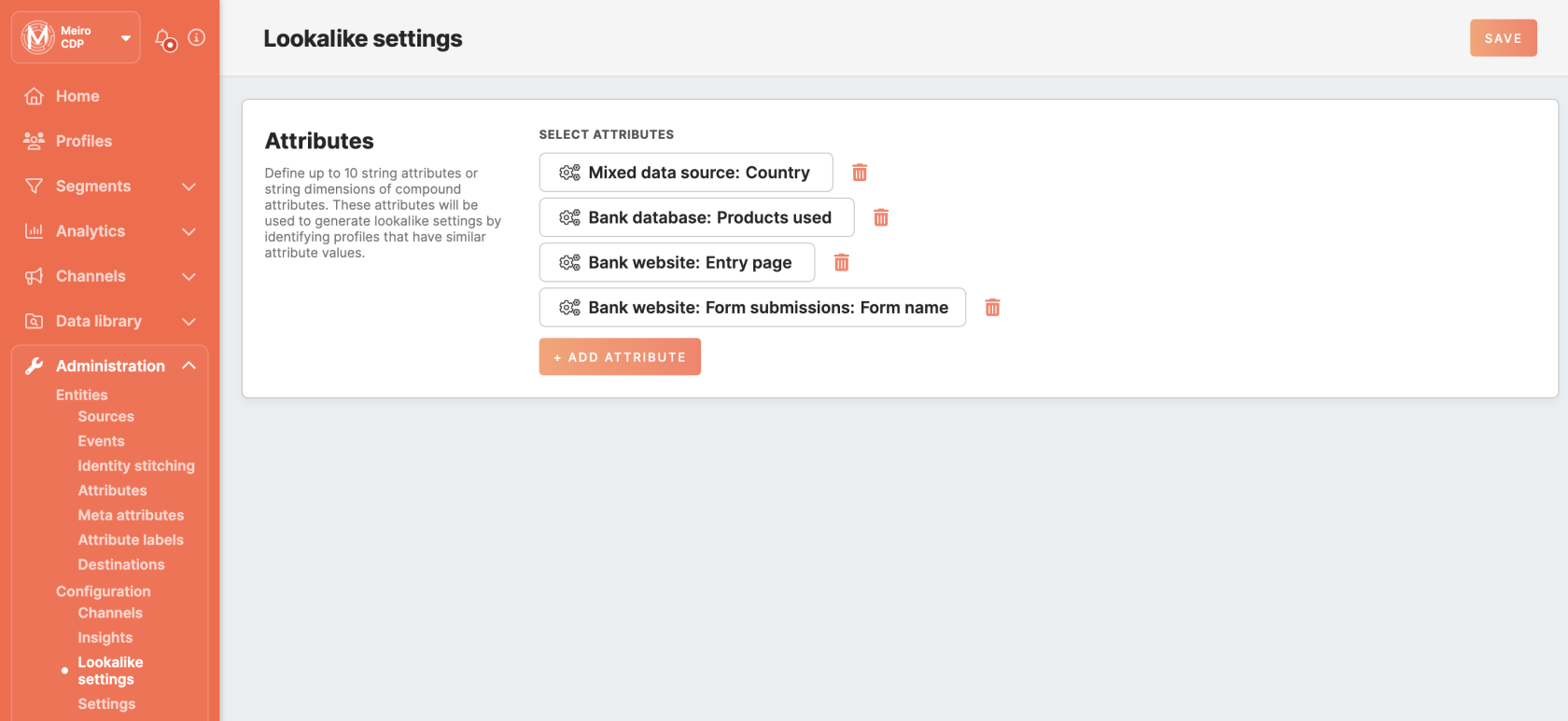Lookalike settings
This feature allows you to leverage your customer data to identify new prospects who resemble your best customers. By selecting specific attributes that describe your customer profiles, our algorithm creates lookalike audiences, enabling you to target potential customers more effectively.
The Administration/Lookalike tab allows setting attributes to enable the possibility of creating lookalike segments under the Segments tab. Configurations are usually done by the Meiro technical consultant. Ensure that your role grants you the necessary permissionspermission to view and edit Lookalike settings.
Select under Lookalike settings up to 10 string attributes or compound attributes with string dimensions without any specific order. These selections will help create lookalike segments by identifying profiles with similar attribute values. At least one attribute must be selected to activate the creation of a lookalike segment within the Segments tab.
Learn more: discover the creation of Lookalike segments and their diverse use cases in this article.
Examples of lookalike settings
When you compare a black box solution for creating lookalike segments to a customizable solution where you can choose the parameters you want, you get an effective strategy tailored to your needs. Several key differentiators stand out:
Tailored Attributes: Users have the flexibility to select and design the attributes that are most relevant to their specific business needs and customer profiles. This allows for a more targeted approach to creating lookalike segments.
Greater Control and Transparency: Offers more control over the segmentation process and greater transparency in how the lookalike segments are derived. Users can understand and adjust the criteria based on which the segments are created.
Industry-Specific Customization: Enables the creation of segments that are tuned to the nuances of a particular industry or market segment, leading to potentially higher accuracy and relevance in targeting.
E-commerce
Scenario: The client operates in e-commerce and wants to optimize lookalike segments for conversions.
Attributes selection:
-
Transactional attributes examples: Average order value, frequency of purchases, recent purchases, time between purchases
-
Behavioral examples: Purchase history, website engagement score, product affinity, preferred communication channel, items browsed or added to wishlist
-
Demographic examples: Age, gender, region
Industry-specific Tips
-
Fashion Retail
-
Focus on style preferences, size ranges, and seasonality of purchases.
-
Consider loyalty to certain brands or designers and frequency of purchase during fashion seasons.
-
Electronics
-
Pay attention to technology affinity, brand loyalty, and purchase frequency of accessories.
-
Look at the upgrade cycle of customers for tech products.
Banking Industry
Scenario: The client operates in the banking sector and aims to optimize lookalike segments to increase new account openings and credit card applications.
Attributes Selection:
- Product in use Examples: Average account balance, types of owned accounts (savings, checking, investments), frequency of transactions, loan history.
- Behavioral Examples: Online banking usage, mobile app engagement, response to past financial offers, types of transactions (e.g., domestic, international).
- Demographic Examples: Age, income bracket, occupation, geographic location.
Industry-Specific Tips
-
Retail Banking
-
Focus on customers' account management patterns, such as savings habits or regularity of deposits.
-
Wealth Management:
-
Look at the lifecycle stage of the customer, such as new professionals, families, or individuals nearing retirement.
Media Industry
Scenario: The client is in the media industry, looking to enhance lookalike segments to increase subscriptions and viewer engagement.
Attributes Selection:
In media, attributes that reflect content consumption preferences and interaction with media platforms are key:
- Behavioral Attributes Examples: Favorite genres or shows, average watch time, peak viewing times, frequency of app or website usage.
- Monetization Model Examples: levels of subscription - anonymous, registered, premium
- Consumption Preference Examples: device usage patterns, like the predominant use of mobile devices, smart TVs, or desktops for streaming.
Industry-Specific Tips
- Streaming Services:
- Focus on viewing habits, such as binge-watching tendencies or preference for certain content types (movies, series, documentaries).
- News Media:
- Pay attention to the types of news content consumed (political, entertainment, sports)
Look at engagement with different formats, such as video news, podcasts, or written articles.
- Pay attention to the types of news content consumed (political, entertainment, sports)

